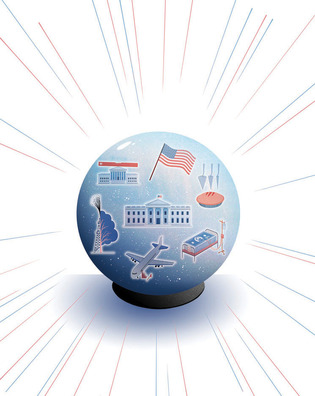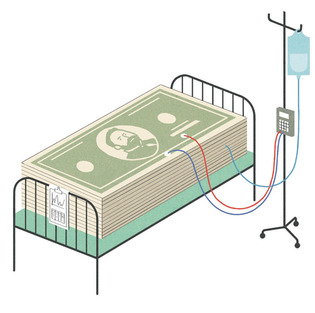 loading
loading
featuresThe next four yearsAs the Trump administration prepares to move in, 11 Yale faculty give their predictions and suggestions.  Michael KirkhamView full image Michael KirkhamView full imageThe economyNobel laureate Robert J. Shiller is a Sterling Professor of Economics.
Donald Trump has predicted that under his plan the US economy will average 3.5 percent growth over the next ten years. That is clearly what his voters want. But is this possible? Such growth rates have happened before. Notably, real GDP growth reached over 10 percent a year from 1933 to 1943, but that was from the bottom of the Great Depression to the peak of World War II, when war production and a patriotic war spirit were highly stimulative. In the three decades from 1950 to 1980 real GDP grew on average 3.9 percent a year. Those were the good, mostly normal, times we would like to call back. But it is not so obvious how to make this happen. Cutting taxes and regulations is not a magic formula for growth. Ronald Reagan promised and did just that. But in the decade following President Ronald Reagan’s inauguration in 1981, real GDP grew only 2.9 percent a year. And, it gets worse. In the 25 years from 1991 to 2016, real GDP has grown only 2.5 percent a year. The reasons for this painful GDP growth slowdown are controversial. In a much-discussed 2016 book, The Rise and Fall of American Growth, Northwestern University professor Robert J. Gordon predicted the high growth rates would never return. He said that the “special century” of 1870–1970 was unique in all of human history, because of some fundamental technological progress occurring over that interval, progress that can’t be made to happen again now. Whether Gordon is right or not, it is certainly true that presidents have not shown any proven ability, other than by not provoking financial crises or other disasters, to promote economic growth. During the campaign, Trump presented himself as a business genius who could inspire and make things happen. I believe Trump is right that inspiration counts for something. His campaign was inspirational to many; some even described it as a revolution. In my 2009 book with George Akerlof, Animal Spirits: How Human Psychology Drives the Economy and Why It Matters for Global Capitalism, we argued that business fluctuations are substantially driven by fluctuations in confidence, in trust, in narratives. Still, I now feel skeptical that Trump can keep anything like his growth promise. There is a risk that his plans will turn out to be another “Great Leap Forward” that the authoritarian Mao Zedong imposed on China during 1958–61, with terrible economic consequences. The social disturbances that Trump creates with his attitudes towards immigrants and minorities may be disastrous. But we were mostly skeptical that Trump would even get elected. He did get elected, and it had something to do with mass psychology. Psychology is very hard to predict. And I don’t want to count him a failure before he even starts. So, I still give him a chance, a relatively small chance, at achieving his promised economic growth.
 Michael KirkhamView full imageThe courtsLinda Greenhouse ’78MSL, a longtime legal writer for the New York Times, is the Knight Distinguished Journalist in Residence and Joseph Goldstein Lecturer in Law at the Law School.
With the Senate confirmation process in Republican hands, President Donald Trump is in a position to reshape the federal judiciary, not only by filling the nearly 100 vacancies that now exist, but by filling dozens or even hundreds more when sitting judges create vacancies by retiring or, more often, moving to part-time “senior status.” While every Supreme Court vacancy is major news, deservedly so, there is more turnover on the lower federal courts than is commonly recognized. In eight years in office, President Obama filled 329 vacancies on the federal district courts and courts of appeals, more than one-third of the 852 congressionally authorized judgeships. With the Supreme Court deciding so few cases these day—only about 70 in recent years, out of more than 7,000 new appeals it receives—staffing the lower courts is a matter of great consequence. Democratic appointees hold a slight edge in both the district and appeals courts, and that will surely change. Since taking control in 2015, the Senate’s Republican leadership drastically slowed down the confirmation process, resulting in the high number of current vacancies. Will the new president be able to reshape the Supreme Court itself? Of course, he arrives with one seat to fill, thanks to Republican obstruction of Chief Judge Merrick Garland, Obama’s eminently qualified nominee for the vacancy created by Justice Antonin Scalia’s death in February 2016. Justice Scalia anchored the court’s conservative wing, and his replacement won’t tip the current knife-edge ideological balance. After that, who knows? Maybe Trump will get lucky, like President Richard M. Nixon, who (until his luck ran out) got four Supreme Court vacancies that enabled him to change the court’s trajectory in major ways. Or maybe he will be unlucky, like President Jimmy Carter, who got no vacancies in four years. With three justices past or approaching 80—two on the liberal side, Ruth Bader Ginsburg and Stephen G. Breyer, plus the key man at the center of the court, Anthony M. Kennedy—many people assume that more vacancies are inevitable in the near future. That is not necessarily the case. Justice John Paul Stevens retired in 2010 at 90, and it’s possible to view his retirement as premature; he is still actively writing, speaking, and traveling at 96.
Five predictionsSteven Brill ’72, ’75JD, a lecturer on journalism at Yale, has written books on homeland security, education, and health care. He founded and ran Court TV and the American Lawyer magazine.
Homeland security: In addition to actual attacks—which, of course, could be a defining event or events for the Department of Homeland Security—this could be a real pothole for an administration that so far doesn’t seem to be immersed in management. The department is perhaps the government’s most complex, hard-to-manage agency, and its management is unusually “customer facing.” Not dealing with high turnover at TSA, for example, would immediately infuriate millions of air travelers. Beyond that, a major challenge of homeland security is having the right leaders in place who can put an attack or attempted attack in perspective, rather than exacerbate fears. That doesn’t seem to be a Trump strong suit. Worse, Trump’s rhetoric is likely to serve as the terrorists’ best recruiting tool. Education: Trump ran on ending Common Core, which is a states-led program that the federal government actually has little to do with. Besides, Common Core is all about setting curricula and achievement standards to help the US compete in a global economy, something Trump would seem to favor. So it’ll be fun to watch him try to deliver on killing Common Core at the same time that he’s likely to try to pursue Obama’s efforts to hold schools and teachers accountable for student achievement—without giving Obama the credit. Law: Look for a rejiggered Consumer Financial Protection Bureau and a Supreme Court rebalanced back toward the right. Both will likely render decisions allowing the continued proliferation of boilerplate arbitration clauses that undermine employees’ ability to sue for alleged discrimination and make it harder for consumers who believe they have been overcharged by banks or cell service providers to get their day in court via class actions. In other words, corporate defendants will be increasingly protected from juries and a public airing of any alleged wrongdoing. And watch Trump, having settled the Trump U. cases for an amount close to his total potential liability, continue to decry “frivolous” plaintiffs’ law suits. This from a man who has sued and mostly lost in thousands of courts. Health care: Trump is fast figuring out that you can’t just get rid of parts of Obamacare. Attempts to do so, or even continued rhetoric pointed in that direction, will unsettle health insurance markets, make hospitals and doctors nervous, and confuse and scare patients. This will be a real circus in the first year. Meantime, health insurance premiums for those whose insurance comes from an employer or from the Obamacare exchanges will continue to be untenable for much of the middle class—because neither Obamacare nor anything Trump is promising goes after the real culprit: exorbitant profit-taking by drug and device companies, medical equipment makers, labs, and supposedly “nonprofit” hospitals. We spend 30 to 100 percent more of our GDP on health care than any other developed country, and the others all deliver the same or better results. That’s what needs to change. Media: With or without Trump, providers of quality journalism will continue to face a deteriorating economic model. But urgent news, or emergencies, attracts eyeballs and readers. So Trump may provide plenty of those eyeballs and readers for national television and print news media and delay their continued decline. Not so for local newspapers, which will be hard pressed to be our only protection against abuses by local businesses (including those “nonprofit” hospitals) and in city halls and statehouses across the country.
 Michael KirkhamView full imageInternational security and world orderCharles Hill, Brady-Johnson Distinguished Fellow in Grand Strategy and senior lecturer in humanities, served as aide to Secretaries of State Kissinger and Shultz.
Every major modern war but one, the Cold War, produced a postwar consensus on how to restore world order. Lacking such a structure, the past 25 years have been dangerously disruptive. With fresh eyes, tested instincts, and options unbeholden to party doctrines, new deals designed by President Trump can renovate the international system. What follows is neither a prediction nor a prescription, but a set of suggestions. Middle East: The United States will insist on full compliance with the US-Iran nuclear “deal” in every regard. We no longer will studiously ignore Iran’s violations of the deal’s letter and spirit. If Iran threatens to abandon the deal, we will call its bluff and react accordingly. We will continue to cooperate with Russia to defeat the Islamic State in Syria while supporting Iraq’s fight against jihadists, actions that indirectly accept Iran’s strategic arc of Shia influence from Tehran to the Mediterranean and in which Syria is the keystone. Assad ultimately will be held to account, but that time will have to wait. We will accord Iran the legitimacy it seeks in return for its good conduct as an international citizen. In parallel we will assist a Saudi-led Sunni bloc to offset Iran’s drive for hegemony. Improved US relations with each can help adjust each side’s strategic space for regional stability. A deal also resides in the Israeli-Palestinian conflict: a trade-off between claims for settlements and for a right of return. A two-state solution would be a defeat for radical Islamism. A US-facilitated, directly negotiated outcome can be securely embedded in and guaranteed by the international system. Russia: Putin has a point. NATO’s expansion eastward and America’s obliviousness to Russia’s historical and cultural ties to the Balkans and Ukraine have encroached on Russia’s strategic space. In retaliation, Russia has entered Georgia, annexed Crimea, and harassed NATO. A deal can be made so each side backs off and strategic spaces are acknowledged even as the territorial integrity of independent sovereign states is respected. Ukraine is key to a deal that makes it neither a Russian satellite nor a NATO member, but a bridge between civilizations. China: The “peaceful rise” of the PRC has begun to transmogrify into a downward spiral toward stalling speed. Beijing remains unable to persuade the people that Chineseness requires communism and capitalism to be one and the same. China’s “One Belt, One Road” is less a benevolent link between Shanghai and Rotterdam than a jobs program for Chinese workers. And China’s artificial-island airbase project in Asia’s maritime waters will be undone as climate change raises the seas. America can accommodate China’s legitimate interests while holding firm on issues of international law and the independence of Asia’s sovereign states. Differences on trade, environment, and human rights can be managed by a deal that requires careful attention to equal rights and responsibilities. Europe: The European Union has become the world’s foremost anomaly through its deconstruction of the continent’s sovereign states and borders in an effort to construct a new entity, which has refused to be a state yet been unable to define what it will be. America’s interest in maintaining the transatlantic partnership that won the Cold War is paramount. To emerge from the current confusion a new deal is needed, a “Transatlantica” for the twenty-first century. The task is to aggregate transnational power and purpose while protecting the sovereign powers of states as historically defined. As Europe works its way toward coherence so should the North American nations regard each other as pillars of a new trans-world dispensation. Tough talk by the new US president toward NATO and Mexico and tough talk in return from them can clear the air, because inequities abound among all the parties and a deal to make the rough places smooth is possible. Deals are best done by common understandings, not by binding laws and newly invented institutions. All these deals are interlinked and could become one Very Big Deal as a platform for even wider adherence from Africa, South Asia, South America, and Oceania—a new structure for a better future.
Criminal justiceVesla Weaver is an associate professor of political science and African American studies.
On the eve of the 2016 election, our nation was poised to shift course in the decades-long prison expansion, bending away from mass incarceration and broken-windows policing. Criminal justice had emerged as the lone arena in American politics where Black Lives Matter activists and leaders on the political right occupied common ground and agreed on the reform needed to undo the damage of the last decades. Our system was roundly judged unfair, ineffective, and mostly, too expensive. Trump’s upset election has ushered in a new political landscape that may signal a return to the “law and order” era. Trump rode to office as a law-and-order candidate—defending stop-and-frisk police tactics, supporting longer mandatory minimums, and overtly connecting blacks and Latinos to criminality—even as many elites believed such a strategy no longer yielded electoral currency in a decade of lowered crime rates. Neither Trump nor his appointment for attorney general, Jeff Sessions, are friendly to the Right on Crime coalition that was crucial to the bipartisan bills of recent years. Sessions is an outlier on criminal justice even in his own party, supporting the private prison industry and opposing even modest bills to lessen some of our harshest sentencing schemes. Trump has signaled that in his first 100 days, he will seek new federal mandatory minimums for nonviolent offenders, a move deeply at odds with public sentiment and the bipartisan consensus. But because so much of the everyday operation of police, courts, and prisons is determined by state and local policy and practice, the Trump administration’s influence on criminal justice hinges on one factor: how much of a chilling effect his leadership will have on reformers. Will local and state momentum continue or will we see it wither on the vine? Many “tough on crime” prosecutors lost election battles to progressive reformers this year. During the November election, even states like Oklahoma that went overwhelmingly for Trump also supported ballot initiatives to reclassify drug possession, and some property offenses, from felony to misdemeanor and to reinvest the savings from decarceration into mental health and drug treatment. So, at least in 2016, voters’ support for law-and-order rhetoric coexisted with a popular wave of progressive reforms. On the other hand, if reform leaders at the state level begin to experience Trump-inspired conflicts within the GOP, efforts may slow. As the political scientist Steven Teles has warned, decarceration cannot occur without the GOP: “Even if every prison and jail in blue states was burned to the ground and their occupants freed, it would only cut the overall level of incarceration by a little over 15 percent.” Moreover, the administration has the capacity to directly affect local criminal justice operations by relaxing the implementation of consent decrees on police departments found to be engaged in a “pattern or practice” of discrimination, misconduct, or brutality—or by not initiating federal investigations in the first place. Imagine that the attorney general had not initiated oversight after the 1990s Rampart scandal in Los Angeles. Or, more recently, in Ferguson. Three critical achievements may not survive: Obama’s executive orders to “ban the box,” which lifted a major barrier to employment for people with a conviction on their records; Attorney General Eric Holder’s important memorandum directing federal prosecutors to focus on high-level dealers instead of nonserious drug crimes; and the DOJ’s decision to end for-profit private prisons at the federal level. And beyond criminal justice, the Trump administration probably will not view key social policy programs relied on by the poor—including his rural white base—as a component of public safety. Half a century ago, we stood in the same place. Then, as now, many criminologists had predicted the end of the penitentiary. Then, as now, rhetoric linking “crime in the streets” with inner-city blacks and politicians warning of a crime wave brought a law-and-order politician to the highest office. That moment a half century ago gave us a prison population that dwarfs most cities, visited on the most vulnerable American citizens and communities. It is unclear whether the movement to reform the criminal justice system today will endure.
 Michael KirkhamView full imageHealth careJacob S. Hacker ’00PhD is the Stanley B. Resor Professor of Political Science and director of Yale’s Institution for Social and Policy Studies.
During the campaign, Donald Trump insisted he would repeal the Affordable Care Act, aka “Obama-care.” Will he, and what, if anything, will take its place? The ACA has reduced the share of Americans without health insurance to 10 percent (versus 18.2 percent in 2010) without spiking overall health costs. It has also, however, encountered continued resistance, as well as a recent string of bad news, including a sharp increase in premiums for subsidized insurance. Because of these challenges—and because it was designed to leave most Americans’ coverage largely untouched—the ACA has never developed a strong constituency. Now it is going to be scaled back. Congressional Republicans have already shown their hand. Early this year, they passed a repeal of the law through the so-called budget reconciliation process, which does not allow a Senate filibuster. (President Obama vetoed it.) Because Republicans have too narrow a majority in the Senate to overcome Democrats’ inevitable filibuster, they will surely use the same strategy in 2017. All signs are that the new president will go along. The 2016 repeal legislation abolished the ACA’s tax credits for insurance, its individual coverage mandate, its Medicaid expansion, its requirement that larger employers provide insurance, and the taxes that fund it. Republicans have also said they will convert Medicaid into a “block grant,” limiting the federal contribution over time and letting states figure out how to spend the reduced amount. President-elect Trump has spoken about keeping parts of the law, such as its ban on preexisting condition exclusions. But these regulations were already set to remain, because they cannot be altered through the budget reconciliation process. Without the other provisions of the ACA, however, such rules could do at least as much harm as good. If, for example, insurers have to cover preexisting conditions, they will raise premiums for those who have them, pricing millions out of coverage. Similarly, the “exchanges” that allow people to buy coverage will collapse if there are no subsidies and no requirement of coverage, as only sicker people will use them. Trump has spoken of “repeal and replace,” but so far, no replacement plan has materialized. Expect Republicans to phase in their repeal to limit the fallout and give themselves time to develop an alternative. But based on “replace” ideas offered to date, also expect the number of Americans without health insurance to climb back up toward historic highs.
Education and research fundingDavid Gelernter ’76, ’77MA, a professor of computer science, is a contributing editor at the Weekly Standard.
Trump is a businessman and believes in markets. He also believes in getting rid of old methods and switching to new ones when the old ones have failed. The old method of handing out government funds to researchers is no good; markets might help change things. Vastly more important, our education system from K-21 has failed. But markets won’t solve this problem. We need brand-new, state-of-the-art thinking. Our current research funding system is an obsolete carryover from the pre-web era. Today it’s all changed, but as is usual in 80 percent of the important cases, technology is being used, naively, to make old procedures more efficient—when it ought to allow us to replace those procedures with fundamentally better ones. The goals of the system should be to minimize time wasted by researchers on raising money, to make a research group’s fund-raising effort strictly proportional to its chances of being funded—and, obviously, to fund good research. Researchers would describe their plans and qualifications in easy-to-find, easy-to-search statements at a website shared by all the US government funding agencies. Every agency should be made to agree: Researchers! Give us your plans in x words, your CV in y, and post them at site Z.gov. Funding officers would spend much of their time searching and browsing this site. When they found something interesting, they’d send a query asking for more detail. Such back-and-forthing would last no more than a few days; then, a decision. Such a system would be the envy of the world. If Yale had any technological foresight, it would develop such a system and offer this “Yale funding system” to the government right now. But it hasn’t. This project is, nonetheless, exactly the sort to appeal to Trump. If only he gets the right advice, the deal is done. One more point: since the 1980s we have all known that US schools are a disgrace, and our universities (except for scientific, technical, and some professional teaching) are about the same. I haven’t yet seen a single online effort that comes close to the solution we need: courses you can review beforehand, that get better (because their associated commentary grows richer) every time a student uses one, that fold up into “permanent digital objects” students can keep around forever. The ideas and technology are ready and waiting. In approaching this field, institutions like Yale have their hearts in the right places, but aren’t famous for speed when it comes to exciting new ideas. Maybe Trump will take an interest.
 Michael KirkhamView full imageThe environmentDaniel C. Esty ’86JD is the Hillhouse Professor of Environmental Law and Policy at Yale’s environment and law schools.
Donald Trump has suggested that he will withdraw the United States from the 2015 Paris Agreement on climate change, increase fossil fuel extraction, and trim EPA’s regulatory powers or eliminate EPA altogether. Whether he moves on all of these campaign promises remains to be seen. Reviving the coal industry in the face of current low natural gas and oil prices seems unlikely. He can tilt EPA away from more-vigorous regulations, but to eliminate the agency he needs a congressional vote, which the Democrats would surely filibuster. And withdrawing from the Paris Agreement requires three years’ notice. But one thing is clear: after 50 years of believing that environmental protection depends on federal government–led regulation, people are awakening to the fact that twenty-first-century sustainability depends on a much broader array of forces—forces that are driving innovation in technology, corporate strategy, public engagement, and investment. Presidents and prime ministers have little day-to-day control over their societies’ carbon footprints. Mayors, governors, and CEOs all have much greater impact on energy choices and environmental outcomes. The Paris Agreement’s commitment to “broader engagement” also means that all nations—not just a subset of developed countries—are now expected to take action. And 188 of them have produced climate change plans. Moreover, where the twentieth-century approach to clean energy relied on the government to pick winners and subsidize chosen companies and technologies, the Paris Agreement emphasizes private investment, leveraged by limited public funds. Governments are no longer seen as the only—or even the best—route to environmental progress. A global phalanx of green consumers, linked by social media, now drives companies to make their products and services more sustainable. Sustainability-minded investors have begun to channel huge swaths of capital away from the polluting enterprises of the past and toward companies making breakthroughs in clean energy and pollution controls. And in our era of transparency and Big Data, an emerging framework of corporate sustainability performance metrics is making it easier to “scorecard” companies, which motivates them to bring a focus on energy and environment into their core business strategies. Of course, the president still matters. Administration policies can provide incentives that spur innovation. But in the twenty-first century, the federal government is not the only actor on the sustainability stage. The drive for clean energy in particular, and sustainability more broadly, now comes from many directions.
TaxesAnne L. Alstott ’87JD is the Jacquin D. Bierman Professor in Taxation at the Law School.
With Republicans controlling both the White House and the Congress, the stage is set for massive tax cuts for businesses and the wealthy. Both President Trump and Speaker of the House Paul Ryan have released plans that would slash taxes. The two approaches differ in the details but share three commitments. First, both plans would lower marginal tax rates (that is, tax brackets), with the top rate falling from the current 39.6 percent to 33 percent. Both would also repeal the 3.8 percent tax on net investment income, which applies to interest, dividends, and other capital income earned by taxpayers with substantial incomes. Second, both would enact unprecedented cuts in business taxes, setting tax rates on business income below the rates on individual income (15 percent in Trump’s plan and 20 to 25 percent in the House GOP plan). Both proposals endorse immediate expensing of business investment—a change that sounds like a technical fix but signals a major policy shift toward converting the US income tax into a consumption tax. Today, businesses can’t deduct what they spend on plant, equipment, and other durable goods. Instead, they depreciate these investments over time, which is the right way to measure income in an income tax. By contrast, a consumption tax seeks to tax only funds spent on personal consumption (like food and rent). Investment in plants and equipment isn’t personal consumption and so should be deducted from the tax base. In practice, governments use different mechanisms to tax consumption: most of us have paid retail sales taxes. But whatever the form, all consumption taxes use some mechanism to avoid taxing business investment. Third, both proposals would repeal the estate and gift taxes. These taxes, which now target gifts and bequests made by the richest 1 percent of Americans, have long been a target for conservatives opposed to the “death tax.” We have no official government numbers quantifying the effects of either the Trump plan or the House GOP plan. But the Tax Policy Center, a respected arm of the Brookings Institution and the Urban Institute, estimates that the Trump plan would lose $6 trillion in revenue over ten years, with business tax cuts accounting for three-quarters of that cost. The Tax Policy Center estimates that the House GOP plan would lose $3 trillion over the same period and award 75 percent of benefits to the top 1 percent of households. We can expect Trump and the GOP to contest numbers like these on the grounds that tax cuts will spur economic growth and fill government coffers. The conservative Tax Foundation, for instance, predicts that economic growth will reduce the Trump plan’s ten-year cost from about $4.4 trillion to about $2.6 trillion. By contrast, the centrist Tax Policy Center finds that macroeconomic effects would reduce the cost of the Trump plan only slightly. Anticipate a heated debate over this so-called “dynamic scoring,” which is sensitive to assumptions and models used.
The presidencyStephen Skowronek is the Pelatiah Perit Professor of Political and Social Science.
The 2016 election season presented the nation with candidate caricatures of a problem at the heart of the modern American presidency: how to reconcile effective political mobilization with responsible governmental management. Candidate Donald Trump was all about political mobilization. He was an insurgent leader instigating a political movement that was as much personal as partisan. He ventured a broadside critique of the state; he cast presidential leadership as a political assault on “the establishment;” he promised a great disruption and a political transformation. In contrast, candidate Hillary Clinton was all about responsible management. She boasted credentials, accomplishments, and competence in solving problems. She offered realism in the exercise of executive power, programs vetted by experts, know-how in the ways of policy making, skill in getting things done. Rather than transform the state, she proposed to make it work. These starkly contrasting styles juxtaposed the very different expectations Americans have for presidential leadership. They also suggested the difficulty of reconciling them. Trump sidestepped serious questions about the feasibility and consequences of his proposals; Clinton seemed to think that the people would rally behind Beltway benevolence. In the process of choosing, the nation tore itself apart. The issues posed here extend beyond the perils of our systems of nomination and election. The competing imperatives of mobilization and management are not resolved with the ascension of a candidate to office, for they are now ingrained within the office. The campaign apparatus is transferred into the White House, where it wrestles with the overhead management agencies of the Executive Office. With little to insulate management from mobilization, there is no ready way for our leaders to sort things out. Time and again, and increasingly since the 1970s, presidents have stumbled over the institution’s demands for both, and notwithstanding our abiding faith in political skill, none has come up with a reliable formula for their reconciliation. Certainly nothing in the Clinton and Trump campaigns suggested to me that either had the magic recipe. We ask our presidents to serve as a source of mobilizing energy potent enough to break through the constitutional gridlock of competing interests and demands. But we also expect the presidency to serve as “policy central,” the locus of responsible problem solving in service to all. It is all but impossible to do both well, but neither alone will suffice. I can’t say that I think this conundrum will resolve itself by its own accord. As I read the recent history, this collision of expectations is growing more, not less, acute. It may be time for reformers to set aside their myopic policy demands and attend more directly to the dysfunctions of institutional design.
 Michael KirkhamView full imageHow we think about governmentGregory Huber is a professor of political science. Elections are, for better or for worse, largely binary choices, and so there is sufficient ambiguity that both winners and losers can read into the outcome their interpretation of why people voted as they did. Despite a small aggregate vote swing, many people view the 2016 election as particularly telling about our capacity to survive social differences or our beliefs about the appropriate role of government. To put it in the context currently being discussed on the Yale campus, did people vote for Donald Trump because of what he said about Mexicans, Muslims, and women, or despite it? Such ambiguity extends also to those who voted for Trump on economic grounds: do they desire more government spending or less government altogether? While these questions ignore the fact that the race was a choice between Clinton and Trump, our focus on Trump now is understandable because he has been chosen to lead. So what are Trump’s goals? What will he focus on? His political past provides little clarity. What Americans will take away from a close election between two historically unpopular candidates now depends largely on the choices that Trump makes as he moves forward as a leader. Economically, will he be a populist, or simply an anti-trade Republican? If the former, then it becomes possible to imagine Americans becoming more positive about government, while the latter suggests continued cynicism. Similarly, how will the choice between short-run economic growth and long-term environmental challenges be managed? Does the United States continue its role as the contemporary peacemaker in Europe and elsewhere? The social front is similarly uncertain, because while Trump has chastised some extreme nativist groups that supported him, the specific policy moves he makes towards refugees and immigrants will likely shape long-term perceptions of the inclusiveness of his administration. In this election in particular, we are as a nation fortunate that we do not judge presidents on their prior behavior or the campaigns they run, but instead on the basis of their leadership while in office.
|
|
7 comments
-

Charlie Walls, 11:04am December 21 2016 |  Flag as inappropriate
Flag as inappropriate
-

John Reid, 2:15pm January 09 2017 |  Flag as inappropriate
Flag as inappropriate
-

Theodore Dushane, PhD, MD, 5:11pm January 10 2017 |  Flag as inappropriate
Flag as inappropriate
-

David Lockman, 11:52am January 12 2017 |  Flag as inappropriate
Flag as inappropriate
-

Richard Reiss, 7:01pm January 19 2017 |  Flag as inappropriate
Flag as inappropriate
-

David Lockman, 12:47am January 30 2017 |  Flag as inappropriate
Flag as inappropriate
-

WJH, 12:18pm July 18 2017 |  Flag as inappropriate
Flag as inappropriate
The comment period has expired.One is impressed by the limp comments here. Perhaps the assignment is placed at an odd time, after the election and before any real actions re policies and laws. The computer science guy suggests breezily a change in the funding protocol that seems to leave out the peer group reviewers current in study sections -- or places them somewhere downstream from a browsing "funding officer." The environmental guy ignores the unusual weight given to men deeply experienced with the business of fossil fuels among the cabinet nominees, ignoring the science experienced. The political scientist calmly accepts diminution of national level organization, accepting states to do all together the job when in fact only a few, or a few cities within them, show anything like the needed commitment. Trump has shown his ability to walk over these sorts of intellects. Slowly, carefully expressed thoughts will be like faint swirls in the dust far behind a crazed herd of marauding elephants.
Oh for a one handed commentator!
Exactly how does Professor Daniel C. Esty write an essay about the environment for the next four years without mentioning that Pres. Elect Trump, along with many high level Congressional Republicans, his likely appointees for the E.P.A. and the Energy Department, and the Vice-President Elect Pence are all on record as climate change deniers?
His dismissive obviously pro-business comment "...in the twenty-first century, the federal government is not the only actor on the sustainability stage" shows his bias.
The piece was called "the next four years" for a reason - it was titled as commentary by Yale's best and brightest on Trump's time in office.
This new administration is a threat to climate change research and progress - a fact not lost on researchers backing up their data offshore for fear of the possible actions of this administration.
Maybe you should have a credible Yale Professor from the sciences rather than an attorney write about the environment.
This article reads as though the President Elect is Merkin Muffley, the fictitious president in the film, "Dr. Strangelove".
It is inconceivable to me how the tepid comments in this article correspond to what we have seen and read to date about the proposed Trump administration. The only explanation I can come up with is extreme editing by someone who supports Trump or is afraid of him.
I won't bore the reader with the numerous examples of Trump's behavior: irrational, vengeful, corrupt, intolerant, and ignorant.
To top it off - to my astonishment - this article doesn't touch on the troubling attitude of Trump towards Russia and Vladimir Putin. We are on the verge of the greatest political crisis this country has faced in over a century - but you wouldn't know that from this article.
Agreed with the comments above -- what vague commentary about a complete reversal of leadership (really, in every dimension).
But if you want to know the animating vision behind the new administration, you can read it here, in a talk Steve Bannon gave to a conservative group at the Vatican in 2014.
buzzfeed.com/lesterfeder/this-is-how-steve-bannon-sees-the-entire-world
It includes this passage:
"And we’re at the very beginning stages of a very brutal and bloody conflict, of which if the people in this room, the people in the church, do not bind together and really form what I feel is an aspect of the church militant, to really be able to not just stand with our beliefs, but to fight for our beliefs against this new barbarity that’s starting, that will completely eradicate everything that we’ve been bequeathed over the last 2,000, 2,500 years."
Today in the Washington Post, Bannon is described as the 'brand' of Trump foreign policy.
https://www.washingtonpost.com/news/josh-rogin/wp/2017/01/19/inside-trumps-shadow-national-security-council
Richard Reiss' comments are absolutely correct.
Given the last 9 days, I honestly think you should retract this article and issue an apology to the Yale community, past and present.
The question is not what will the next four years look like - instead, we should be asking how this incompetent tyrant can be removed from power in the most expeditious manner.
I didn't even read the article as I only wanted to see what "Yale Alumni" readers would comment, only based on the title of this piece.
I thought that "smart people" would have smart comments. There were a few. But the latter are immature and typical and leave a bad taste in EVERYONE'S mouth.
An American IS, not "is supposed to be", a proud person!
Either support the President of the United States or keep your comments to yourself. It's just an article written by someone with an opinion. If you want to write an article, then APPLY FOR THE JOB!
This isn't the five o'clock news, filled with negativity. We don't need any more negativity in this world/country.
Maybe some of YOU commenters should apologize to the Yale community, "past and present" for adding to the negativity of the world.
Instead of taking time to comment negatively, maybe you should take the time to volunteer your time to those less fortunate and be a positive influence.
-Always Positive.